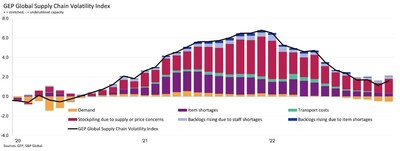- Business reports of safety stock-building rise, particularly in Europe and North America, partly reversing companies' recent destocking efforts
- COVID-19 resurgence in China increased supply chain volatility, bucking improvements during the second half of 2022
- Europe's supply chains remained the most stretched in December
CLARK, N.J., Jan. 19, 2023 /PRNewswire/ -- The GEP Global Supply Chain Volatility Index — a leading indicator tracking demand conditions, shortages, transportation costs, inventories and backlogs — shows declining demand for raw materials, commodities, and other components needed to provide finished goods and services in December, reflecting the growing risk of a recessionary period ahead.
Additionally, more businesses are safety stockpiling inventories, particularly in Europe and North America, due to a resurgence in COVID-19 infections in China and increased concerns about future supply and pricing, partly reversing destocking efforts seen in the prior six months.
As a result of greater safety stockpiling and worsening of labor shortages, the GEP Global Supply Chain Volatility Index rose — up from 1.15 in November to 1.61 in December — halting the improvements in the world's supply chains, which began in the summer of 2022.
Commenting on the latest results, John Piatek, GEP's vice president of consulting, said: "We are shifting from a sellers' to a buyers' market, and companies should be pushing back hard on all price increases from their suppliers, which will continue to drive down inflation. Falling demand signals the increasing likelihood of a global recession in the first half of 2023."
The key findings from December's report:
- DEMAND: Demand for components, raw materials, commodities and any other items companies need to provide their goods and services declined further in December, especially in North America.
- INVENTORIES: Global business reports of safety stockpiling are up since November, which is a key factor behind December's increase in GEP's Global Supply Chain Volatility Index.
- LABOR SHORTAGES: Companies report an uptick in labor shortages, causing supplier capacity to be stretched.
- MATERIAL SHORTAGES: Global supply shortages are at their lowest level since September 2020 as suppliers continue to adjust to market conditions. Easing demand has reduced competition for items.
- TRANSPORTATION: Transportation costs are at their lowest in over two years, highlighting weaker pressures on shipping, train, air and road freight.
- REGIONAL SUPPLY CHAIN VOLATILITY: Supply chains feeding into Europe remain the most stretched, compared to Asia and North America, in December.
ABOUT THE GEP GLOBAL SUPPLY CHAIN VOLATILITY INDEX
The GEP Global Supply Chain Volatility Index is produced by S&P Global and GEP. The GEP Global Supply Chain Volatility Index is derived from S&P Global's PMI™ surveys, sent to companies in over 40 countries, totaling around 27,000 companies. These countries account for 89% of global gross domestic product (GDP) (source: World Bank World Development Indicators).
The headline figure is the GEP Global Supply Chain Volatility Index. This a weighted sum of six sub-indices derived from PMI data, PMI Comments Trackers and PMI Commodity Price & Supply Indicators compiled by S&P Global.
The GEP Global Supply Chain Volatility Index is calculated using a weighted sum of the z-scores of the six indices. Weights are determined by analyzing the impact each component has on suppliers' delivery times through regression analysis.
The six variables used are 1) JP Morgan Global Quantity of Purchases Index, 2) All Items Supply Shortages Indicator, 3) Transport Price Pressure Indicator, and Manufacturing PMI Comments Tracker data for 4) stockpiling due to supply or price concerns, and backlogs rising due to 5) staff shortages and 6) item shortages.
A value above 0 indicates that supply chain capacity is being stretched and supply chain volatility is increasing. The further above 0, the greater the extent to which capacity is being stretched.
A value below 0 indicates that supply chain capacity is being underutilized, reducing supply chain volatility. The further below 0, the greater the extent to which capacity is being underutilized.
A Supply Chain Volatility Index is also published at a regional level for Europe, Asia, North America and the UK. The regional indices measure the performance of supply chains connected to those parts of the world.
For more information on PMI surveys, PMI Comments Trackers and PMI Commodity Price & Supply Indicators, or the GEP Supply Chain Volatility Index methodologies, please contact economics@ihsmarkit.com.
About GEP
GEP® delivers transformative supply chain solutions that help global enterprises become more agile and resilient, operate more efficiently and effectively, gain competitive advantage, boost profitability and increase shareholder value. Fresh thinking, innovative products, unrivaled domain expertise, smart, passionate people — this is how GEP SOFTWARE™, GEP STRATEGY™ and GEP MANAGED SERVICES™ together deliver supply chain solutions of unprecedented scale, power and effectiveness. Our customers are the world's best companies, including more than 550 Fortune 500 and Global 2000 industry leaders who rely on GEP to meet ambitious strategic, financial and operational goals. A leader in multiple Gartner Magic Quadrants, GEP's cloud-native software and digital business platforms consistently win awards and recognition from industry analysts, research firms and media outlets, including Gartner, Forrester, IDC, ISG, and Spend Matters. GEP is also regularly ranked a top supply chain consulting and strategy firm, and a leading managed services provider by ALM, Everest Group, NelsonHall, IDC, ISG and HFS, among others. Headquartered in Clark, New Jersey, GEP has offices and operations centers across Europe, Asia, Africa and the Americas. To learn more, visit www.gep.com.
About S&P Global
S&P Global (NYSE: SPGI) S&P Global provides essential intelligence. We enable governments, businesses and individuals with the right data, expertise and connected technology so that they can make decisions with conviction. From helping our customers assess new investments to guiding them through ESG and energy transition across supply chains, we unlock new opportunities, solve challenges and accelerate progress for the world.
We are widely sought after by many of the world's leading organizations to provide credit ratings, benchmarks, analytics and workflow solutions in the global capital, commodity and automotive markets. With every one of our offerings, we help the world's leading organizations plan for tomorrow, today.
About PMI
Purchasing Managers' Index™ (PMI™) surveys are now available for over 40 countries and also for key regions including the eurozone. They are the most closely watched business surveys in the world, favoured by central banks, financial markets and business decision makers for their ability to provide up-to-date, accurate and often unique monthly indicators of economic trends.
Disclaimer
The intellectual property rights to the data provided herein are owned by or licensed to S&P Global and/or its affiliates. Any unauthorised use, including but not limited to copying, distributing, transmitting or otherwise of any data appearing is not permitted without S&P Global's prior consent. S&P Global shall not have any liability, duty or obligation for or relating to the content or information ("data") contained herein, any errors, inaccuracies, omissions or delays in the data, or for any actions taken in reliance thereon. In no event shall S&P Global be liable for any special, incidental, or consequential damages, arising out of the use of the data. Purchasing Managers' Index™ and PMI™ are either registered trade marks of Markit Economics Limited or licensed to Markit Economics Limited and/or its affiliates.
This Content was published by S&P Global Market Intelligence and not by S&P Global Ratings, which is a separately managed division of S&P Global. Reproduction of any information, data or material, including ratings ("Content") in any form is prohibited except with the prior written permission of the relevant party. Such party, its affiliates and suppliers ("Content Providers") do not guarantee the accuracy, adequacy, completeness, timeliness or availability of any Content and are not responsible for any errors or omissions (negligent or otherwise), regardless of the cause, or for the results obtained from the use of such Content. In no event shall Content Providers be liable for any damages, costs, expenses, legal fees, or losses (including lost income or lost profit and opportunity costs) in connection with any use of the Content.
View original content to download multimedia:https://www.prnewswire.com/news-releases/global-demand-for-materials-and-components-declines-further-in-december-signaling-the-increasing-likelihood-of-a-recession-gep-global-supply-chain-volatility-index-301725855.html
SOURCE GEP






















































